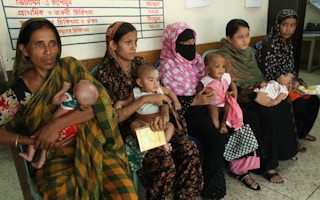World population continues to grow. The latest UN projections, released this week, indicate that we will add another 2 billion people to the planet by 2050 and 3 billion by the end of the century. While population growth is ebbing in many countries—and even starting to contract in a few—population growth in some countries remains brisk, if not breakneck.
India, for example, is projected to add 273 million people by 2050 under the scenario UN demographers consider most likely, overtaking China as the most populous country in the world. The population of sub-Saharan Africa is projected to double from about 1 billion to just over 2 billion by mid-century.
In releasing the projections, UN demographers point out that such rapid growth can pose challenges for efforts to eradicate poverty, end hunger, provide health care and education to all and arrest environmental degradation.
And indeed, one need only look to the news of the day to get a snapshot of how continued population pressure could perilously collide with other global concerns.
Just this week, dozens have died in a heat wave that is gripping India, where authorities have ordered police to escort water tankers as growing numbers of people compete for limited water supplies.
An Ebola outbreak in Uganda has renewed concerns over the possibility of another pandemic, like HIV-AIDs, erupting on a continent with a rapidly urbanising population and poorly prepared public health systems.
Last month, researchers in Australia analysed global climate change data to develop long-term risk scenarios, emphasising that without more serious action to reduce greenhouse gas emissions, civilisation as we know it could collapse by mid-century.
The apocalypse may be not imminent, but with population projected to grow from 7.7 billion today to 10.9 billion by 2100—and a global middle class that is also rapidly expanding—struggles over land, water and other resources could easily intensify.
There are steps that can be taken to feed and accommodate more people on the planet. We can invest greater resources in agricultural technology that will help us produce needed food in the face of heat and drought. We can build more schools, more health clinics, and train more teachers and doctors.
“
With population projected to grow from 7.7 billion today to 10.9 billion by 2100—and a global middle class that is also rapidly expanding—struggles over land, water and other resources could easily intensify.
And, if we get our act together, we can do a lot more to avoid the worst impacts of climate change.
But we should also recognise that demographic projections are not carved in stone. It’s not remotely inevitable the world will have 10.9 billion people in 2100. That’s simply the UN’s “medium variant” projection.
Small, unanticipated changes in fertility could radically alter the projections. The UN says there is a 27 per cent chance the world’s population will stabilise or even decrease by 2100 or earlier, but it could also be higher. But with a 95 per cent confidence level, UN demographers believe that the world’s population will be somewhere between 9.4 and 12.7 billion by 2100.
Certainly, a world of 9.4 billion offers greater chances of addressing the many challenges humanity faces than a world of 12.7 billion. And greater investment in the health and rights of women around the world can help get us there.
We know that socioeconomic improvements—such as reductions in child mortality and increased urbanisation—can lead to declines in fertility, but the empowerment of women is key.
Investing more in the education of girls and improving job prospects for women is crucial. Equally important is access to contraception and reproductive health care, without which even empowered women experience high levels of unintended pregnancy.
In releasing its report, the UN Population Division notes that “accelerated expansion in access to family planning information and services could result in a more rapid fertility decline and a smaller global population in the future than projected under the medium variant.”
Far from controlling women’s reproduction, we need to promote their reproductive freedom. We’ve made strides in expanding access to family planning and reproductive health care, but too many girls and women are still left behind. When we invest in their well-being, health, and capacity to make their own choices about childbearing, a brighter future is possible for all.
Kathleen Mogelgaard and Robert Engelman are senior fellows with the Population Institute in Washington, DC. This story was published with permission from Thomson Reuters Foundation, the charitable arm of Thomson Reuters, that covers humanitarian news, climate change, women’s and LGBT+ rights, human trafficking and property rights. Visit http://news.trust.org/climate.



















